“To Fill a Room with ‘Nobody’”
Emily Dickinson and mitochondria go under the microscope in this Pushcart-nominated essay from our “Small Things, Partial Cures” issue of 2018.
“Mitochondria, the tiny products of endosymbiosis, made it possible for Emily Dickinson to write over 1,700 poems and for Charles Darwin to climb 4,000 feet into the Andean foothills.”
By Sara Talpos
One summer, after ten years of writing poetry and teaching composition classes, I enrolled in a microbiology class at our local community college. I felt hesitant and out of place in the lab.
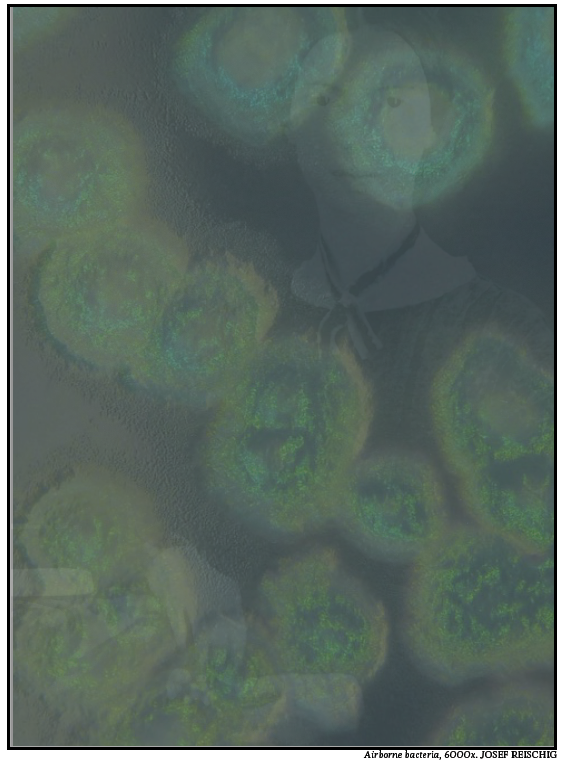
Still, I relished our earliest assignment: Use a light microscope to bring Pseudomonas aeruginosa into focus in three minutes or less. The bacteria, stained pink and magnified 2,000 times, looked like tiny pill capsules scattered across the slide.
If I could line them up lengthwise — 18,000 of them — they would stretch as far as the first line in Emily Dickinson’s poem “Estranged from Beauty”:

When Dickinson sensed beauty in the infinite, when she questioned the underpinnings of human identity, could she have been imagining bacteria? I like to think it’s possible. Bacteria and other microorganisms were discovered in the late 1600s, roughly a century and a half before her birth. Dickinson’s words resonate with me now when I look through the microscope at our boundary-hopping ancestors. These hands that turn the microscope’s nob, these eyes that peer into the lens — the body I call “mine” — evolved from single-celled bacteria. That bacteria may have resembled my P. aeruginosa, an organism that’s ubiquitous in soil and water and even on human skin as part of a larger microbial community.
***
As a microbiology student, my tidy definitions fall away. Self, species, heredity. In high school, I learned that genes are passed from parent to offspring. Bacteria, however, can transfer genes between individuals of the same generation and even between individuals of different species. For example, some bacteria use a hairlike appendage called a “sex pilus” to reach out and attach to a nearby bacterium. Once contact has been made, the two individuals are drawn together and DNA is transferred from one bacterial cell to the other, presumably through pores in their cell membranes.
This movement of DNA across membranes reminds me of poetic enjambment: how a sentence or a thought is carried across a boundary — the poetic line — without punctuation to stop it. In stanza 2 of Dickinson’s “Before I got my eye put out,” for example, the sentences overflow from one line to the next:

Here the sky is so vast it cannot be contained by a single poetic line; the idea of sky must continue unbroken into the next line. Nor can the sky be possessed by the speaker. Rather, the sky threatens to “split” her comparatively small body and mind.
Fortunately, we humans are not completely permeable to the outside world. Unlike bacterial DNA, ours is mostly housed inside a nucleus that prevents easy swapping of genetic material. Still, as a species, we would not exist without bacteria. The human gut provides a home for many bacterial species, which benefit humans by digesting food and synthesizing vitamins. In this classic example of symbiosis, each species benefits from living with the others. But what if two symbiotic species were to merge even more intimately?
The biologist Lynn Margulis (1938–2011) helped advance the theory of endosymbiosis: the merger of two different species to create a new, more complex species. In 1967, she published a paradigm-shifting paper, arguing that cells possessing a nucleus — including most cells in the human body — evolved only after two distinct types of bacteria physically merged, became one, and started to reproduce. “On the Origin of Mitosing Cells” was rejected by fifteen scientific journals before finding a home at the Journal of Theoretical Biology.
Three years later, Margulis published her first book, Origin of Eukaryotic Cells, in which she further explained and provided evidence for endosymbiosis. Still, the theory remained controversial among scientists, in part because it modified long-held beliefs about how evolution works.
Consider Charles Darwin’s tree of life, different species branching away from a common ancestor. Endosymbiosis asks us to imagine some of the individual branches on the tree of life joining together, forming loops. I think about this while teaching my daughter to tie her shoes. The purple laces bounce against her pink sneakers as she runs ahead of me to school.
The energy that propels my daughter down our street is generated inside her cells by structures called mitochondria. A mitochondrion is spherical and small — about half the length of the P. aeruginosaI located on my microscope slide. Its primary function is to provide our bodies with usable energy. More than forty years after Margulis’s paper on mitosis, it is now widely accepted that mitochondria are remnants of once free-living bacteria. Somewhere way back on the evolutionary tree, microorganisms of two different species merged to form the large energy-producing cells that now characterize humans and other animals. We are the products of endosymbiosis. It appears that Dickinson was correct — figuratively and genetically — when she questioned humans’ “power to be finite.”
Lynn Margulis was an admirer of Dickinson, naming two of her own books — Slanted Truths: Essays on Gaia, Symbiosis, and Evolution,1997and Dazzle Gradually: Reflections on the Nature of Nature, 2007 — after lines in the poet’s famous poem “Tell all the Truth.”
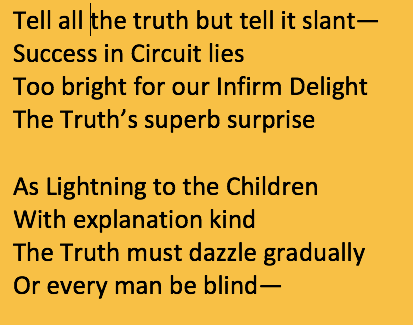
For Margulis, truth itself was “slanted,” requiring careful observation and a willingness to look beyond commonly held assumptions. Perhaps she was dazzled gradually by the unfolding discoveries made possible by new genetic tools and methods in the 1970s that lent support to her theory.
This affinity may have originated along a shared border: From 1988 until her death, Margulis lived in Amherst, Massachusetts, in a house next to the poet’s former home, now the Emily Dickinson Museum. In the year before her death, Margulis reportedly said, “Emily Dickinson talks to me all the time. She is my neighbor. She is ironic. She exposes pretentions. She is a botanist. She is my favorite poet.”
The Dickinson Museum includes a garden where the poet cultivated flowers. The museum website showcases foxgloves, their blossoms like purple bells, spilling from a shared stalk, proof that a single growing thing contains multitudes.
Dickinson often presented her flowers along with her poems as gifts. Her family and friends knew her as a gardener and a poet. She was not content to be “Nobody” in the eyes of outsiders. She chose not to enter the marketplace and publish her poems when doing so required altering her work.
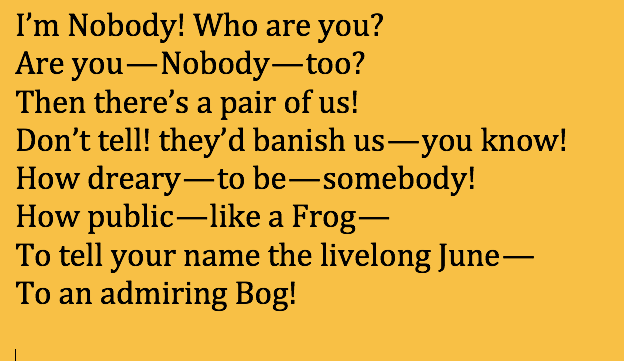
“I’m Nobody” suggests camaraderie — connection — between the poet and her addressee, whom Dickinson invites to share the “Nobody” moniker.
Mitochondria and other microscopic entities are tiny nobodies, overlooked but plainly here, waiting to be heard. For much of the twentieth century, Western culture tried to banish microbes, overusing antibiotics, antimicrobials, and fungicides. This was an unfortunate result of the germ theory of disease, which took shape during Dickinson’s lifetime. While a small percentage of bacteria can harm humans, a healthy human body contains roughly as many microbial cells as human cells. I think of these beings as true Nobodies, in the Dickinson sense, existing without frippery or fanfare, but nonetheless important.
Emily Dickinson was a trained observer of the natural world. At age nine, she entered Amherst Academy, where she studied for seven years; among the subjects she studied was botany. She made her own herbarium. The University of Michigan, where I studied biology, has a facsimile edition published by Harvard University Press: a surprisingly weighty and oversized book, complete with slipcover. It presents digital photos of the original pressings, which amount to 424 plants. The facsimile’s notes explain that there “does not appear to be an overall [scientific] order to the collection.” Yet Dickinson labeled most of the plants by hand, writing their scientific names on slender white tabs affixed to each specimen. The plants appear purposefully arranged on the page. On page 60, the branching leaf of Lathyrus odoratus finds the empty space around the thin and leafless stem area of Anenome cylindrica. Like a slant rhyme, the curved stem of the former echoes the curved stem of Saturjea vulgaris.
***
Moving between magnifications, adjusting the light, I seek the desired density of pink on my microscope slide. Viewing P. aeruginosa from so many perspectives, I begin to feel an affinity for it. Looking through a microscope requires leaving my human-scaled world, the buckets of mordent and dyes, my lab partners, my notebook and pencil. It is similar to performing a close reading of a poem. In Dickinson’s writing, the enjambment and unexpected line breaks require that I look and look again, reconsider where the poem is heading. Peering through a microscope, I’m never quite sure what my slide with its blot of pink or purple dye will reveal. Microscope work is remarkably like close-reading a poem.
In an intriguing article published in The Emily Dickinson Journal, Joan Kirkby explores the “correspondences and echoes” between Dickinson’s poetry and the scientific debates of her day, specifically those accompanying the Darwinian revolution. The article notes that during some of Dickinson’s most productive writing years, New England was the site of vigorous evolutionary and theological debates. Further, “Emily Dickinson herself was imbricated in a unique web of affiliation with Darwin and Darwinian ideas; the key New England figures in this debate were all known to Dickinson” through family, school, libraries, and the periodicals to which her family subscribed. Kirkby argues that Dickinson, through her poetry, “participated in the reconceptulalization of the world that was taking place around her.” Her poetry creates a space to explore the cultural implications of evolution: what it means to live in a world marked both by extinction, and by ever-changing biological diversity.
One of my favorite poems, “It’s all I have to bring today — ,” addresses what I believe the poet, the microbiology student, and the naturalist share in common. The opening “It” may refer literally to a nosegay of Dickinson’s flowers, presented along with a poem to a family member or friend. Then again, the “It” could be something figurative that links us to the infinite. Notably, this thing is small: a P. aeruginosaor a few lines of a poem or my daughter’s crayon drawings or the stone my son picks up on the walk home from school:
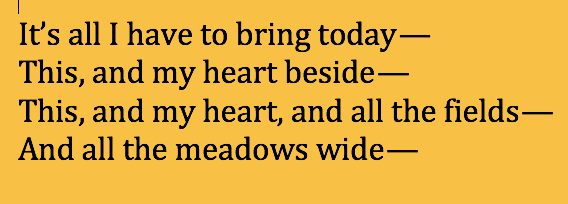
The dash at the end of each line points toward the white space of the page, an open field, spaciousness. This is unlike the enjambment in “Before I got my eye put out,” which emphasizes the limits of the poetic line; it cannot contain an idea or place such as the sky. Here, instead, the dashes seem to reach out into the vastness, connecting the objects with something beyond themselves. I welcome the transformation of “It” into the more immediate “This,” which expands to encompass the speaker’s heart.
By line 4 (“And all the meadows wide — “), one might sense that the poem’s enumeration could go on forever; however, the next lines offer instruction:

I hear sadness in the possibility of forgetting. This tempers the tone in line 6, where a pun links “some one” with “sum.” To suggest that individuals are the sum of many? Or that the sum is all there is, though we forget to count?

Having widened her perspective to include fields and meadows, the speaker concludes by reminding us of what she sees when she narrows her focus: bees and clover. But this is not a narrow vision, for these things are changed in our minds, inextricably connected with the entire universe.
And this “This” is why Dickinson and the microscope hold equal positions in my mind and heart: Mitochondria, the tiny products of endosymbiosis, made it possible for Emily Dickinson to write over 1,700 poems and for Charles Darwin to climb 4,000 feet into the Andean foothills. Mitochondria helped me give birth, twice. They allow me to tie a shoelace and stow The Essential Dickinson (weighing 171 grams) in my purse. They fill a room with Nobodies — and the room keeps expanding.
************************************************************************************
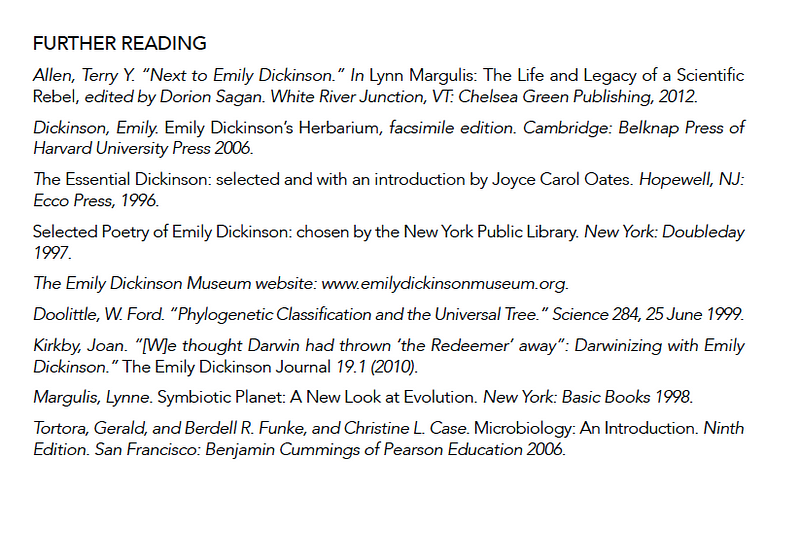
*****************************************************************************
Sara Talpos writes frequently about medicine, public health, and the environment. Her articles and essays have appeared in Kenyon Review, Undark, Mosaic, Medicine at Michigan, and numerous other publications. She is also a poet, with work in RHINO and Bellevue Literary Review, among others.
This essay, “To Fill a Room with ‘Nobody,’” was on of Broad Street’s nominations for the Pushcart Prize. Keep Fingers crossed!










